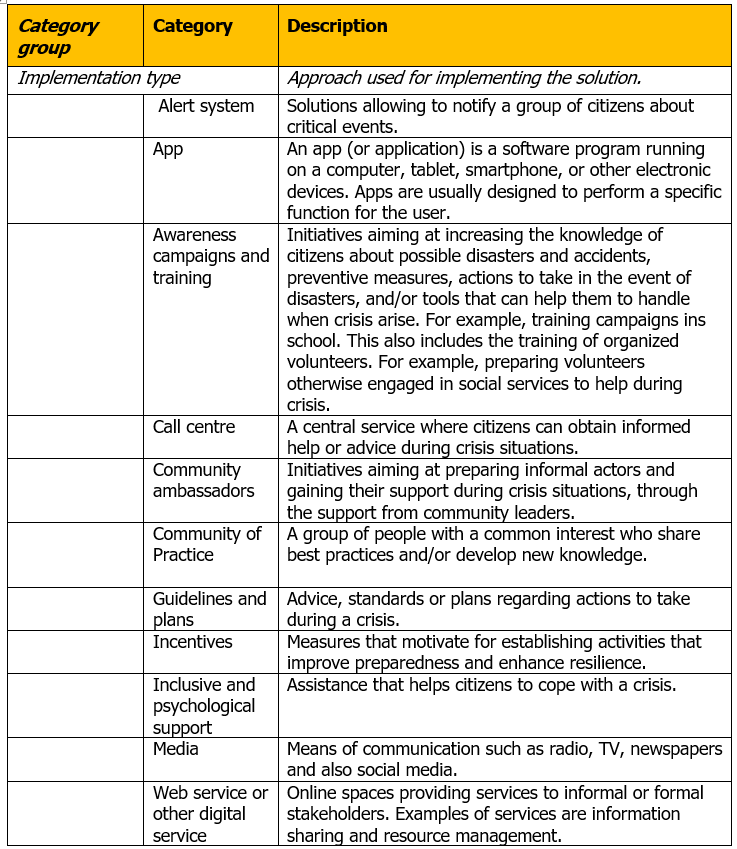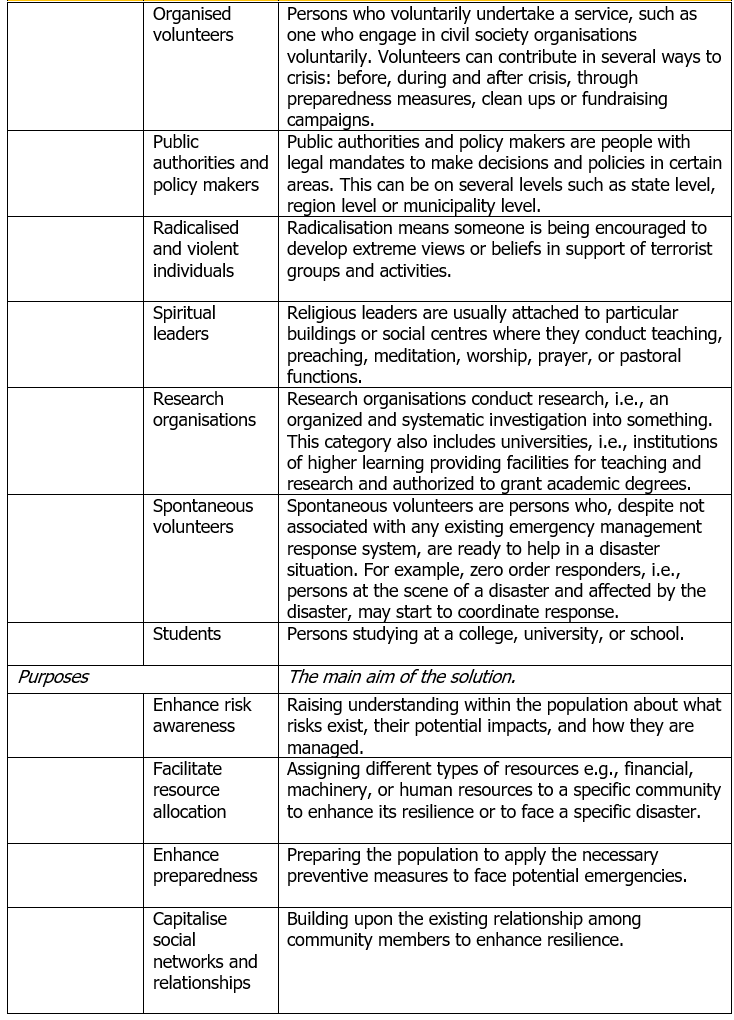Glossary
The following list of concepts helps users of the catalogue of solutions and/or the knowledge platform to understand ENGAGE’s central terms.
Contextual aspects
When people react to crisis, they rely on their immediate and larger environment to cope with it and they rely on their skills and their experiences, “their background” to overcome it. They deal with a disaster in creative and unexpected ways, because they relate to their surroundings to clarify the meaning of a disruptive event. In other words, they use context to be resilient. ENGAGE believes that understanding this context is key to improve the relationship between citizens and those whose profession it is to help them to deal with crises, since social context does not only help an individual coping with a catastrophe, it is the condition that makes resilience possible.
However, for isolating those specific parts that are really a condition for our survival and those of others in a disaster, we need to identify specific aspects in this context, that are more relevant than others. We call these conditions “contextual aspects”, since they are enabling individuals, social groups or society as a whole to act before, during or after a crisis for coping with it. They refer first to a specific social context that is enacted during a crisis. A neighbor, who helps us with provisions during a dire situation might be one example. The way we react based on our skills could be another. Nevertheless, contextual aspects go beyond an individual’s experience during a crisis, since they relate back to the structure of society. The way a city is built, the density of civil society organizations in a society or economic and social inequality can all become relevant in specific ways during a crisis.
Target aspects
Most of aspects of social life that enable people to be resilient during a crisis can be directly affected by an outside tool. Economic resources, the social network, the professional skills of an individual are not easily changed and have a decisive impact for overcoming a disaster. Hence, it is crucial to distinguish between conditions for societal resilient that can be changed and those that are resistant to an intervention because they are deeply inscribed in social structures and could only be affected by a complex or far reaching transformative process. Other contextual elements, political or religious beliefs and values should not be addressed by technical solution for ethical and political reasons. For this reason, at ENGAGE, we identify contextual aspects that can and should be directly influenced for enhancing societal resilience. We call these context conditions “target aspects”, since those are the elements that the solution presented in our catalogue of solutions intends to target.
Solutions
ENGAGE’s ambition is to improve interactions between those who are affected by a crisis and try to overcome its effects and crisis professionals who routinely plan and prepare for disasters. The project’s objective is to make crisis professionals, emergency organizations and authorities, aware of the potential of what people to do in crisis and at the same time bring these professionals closer to what is needed to “bounce back” after a disruptive event as an individual, a social group or a whole society. Our approach is based on what we call “solutions”, a deliberately wide term that covers technologies, tools, processes, guidelines, practices, that improve interactions between first responders, authorities and society. Even though they address specific target aspects, they should always encompass a transformative ambition for society as a whole to enhance societal resilience. Nevertheless, they are are designed to achieve specific benefits before, during, or after a crisis.
Emergency organizations
A wide array of specialized non-state organizations operates today to prepare for crisis, mitigate their impact and recover from them. These organization are composed of professional whose profession it is to deal with disasters and volunteers who are trained to assist victims of disasters. These organizations and their members have in common that they all rely on specific procedures and tools to do their job. The are formalized crisis actors. This puts them sometimes at odds with informal actions of citizens who respond to disaster. For this reason, ENGAGE propose a series of solutions that help emergency organizations to improve their interactions with citizen’s for improving societal resilience.
Authorities
A set of institutions and organization having legitimate political and administrative power are normally responsible for disasters and crisis preparedness and management. Highly formalized, they base their actions on disaster planning and a set of specialized professionals and experts to do so. This let’s them sometimes perceive spontaneous, informal coping of citizens disaster as a nuisance. For this reason, ENGAGE propose a series of solutions that help authorities to recognize and use the potential of citizen’s action during a disaster by proposing a catalogue of solutions to improve interactions with society.
End-user
The solutions that we analyze and catalogue in ENGAGE’s catalogue of solutions address specific organizations and individuals. Even though transferability is a criteria for integrating solutions in our catalogue, ENGAGE highlight that solutions are always dependent on a specific context to be able to function properly. This entails having the potential end-user in mind when we analyze the potential of solutions to enhance societal resilience.
Citizens
ENGAGE’s tries to tap in society’s potential for overcoming disasters and crisis. This means addressing specific social groups, but also each citizen, understood as a recognized member of a given society, and improving her or his interactions with emergency organizations and authorities. Also focusing on the individual citizen enables ENGAGE to integrate solutions in its catalogue of solution that directly improve communication, but also transfer of knowledge via an individualized interface.
Situational awareness
One of the target aspects that solutions in ENGAGE’s catalogue of solution focuses on is situational awareness. Disaster situations are often quickly evolving and citizen’s have to adapt to changing circumstances to be resilient to the effects of a crisis. To understand what happens during an unfolding disaster by connecting different elements around us and the capacity to give sense to the situation is a condition for acting accordingly. Situational awareness can be enhanced by different means: For instance, maps or information feeds can help citizen’s to situate themselves in time and space during a crisis. Communication tools can point to priorities, risks and dangers or make us aware that we are not isolated.
Alertness
Becoming aware of risks helps us to understanding our situation, but we need to be willing to act to overcome. This willingness to act while aware of a situation is captured by the term of alertness.
Trust
The expectations that others will assist us when a disaster strikes and the fact that those who surround us are a source of security rather than a menace refers to the importance of trust in crisis. Trust can be interpersonal or collective, but it is always necessary condition for cooperation. It plays notably an important role for structuring interactions between citizens and emergency organizations and authorities
——————————————————————————————————————————————————————————————-
The content of the Knowledge Platform uses a number of terms related to tools and methods for disaster management and citizens’ participation in disaster management. The terms are used in the presentation of the solutions included in the Catalogue of Solutions. Some of them are used in filtering.
The following glossary provides the definition of these terms.
Terms used in the description of basic information for the solutions







